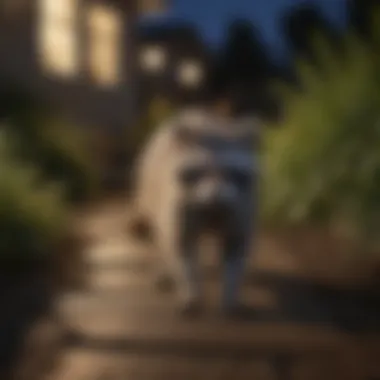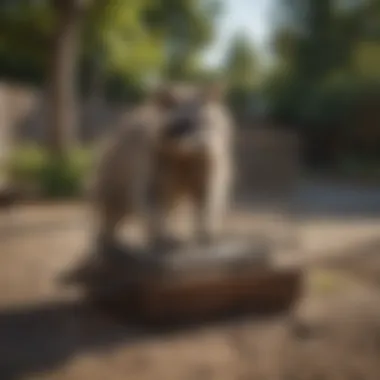Assessing Raccoon Trapping: Legitimacy and Methods


Preventive Pest Control Strategies
Preventing raccoons and other pests from making your residential space their home begins with a strategic approach aimed at disrupting their comfort zones. Preventive pest control strategies serve as the first line of defense against unwanted wildlife intrusions. These methods not only safeguard your property but also reduce the chances of costly damage while promoting a healthier environment for both humans and wildlife.
House Exterior Protection
Tips for sealing cracks
One of the primary methods to prevent raccoons from entering your home is by carefully sealing any available cracks or holes in the exterior. Raccoons are adept at finding weaknesses in buildings. To seal gaps effectively, apply caulk or expanding foam to holes, especially those around plumbing pipes, windows, and doors. Regular inspections are essential for identifying vulnerable areas.
Clearing debris
Debris, such as wood piles and accumulated leaves, serves as an inviting shelter for raccoons. Maintaining your property's cleanliness determines how animals perceives it. Regularly clearing these and ensuring proximity to your home reduces their chances of nesting nearby. Moreover, trimming branches that stretch over windows can obstruct easy access to your roof.
Preventing pests from entering
Implementing deterrents like raccoon-proof garbage cans can aid in discouraging these animals from frequenting your property. Such products are specially designed to lock tight lids, preventing scavenging. Additionally, use rodent-proof trash bags which not only minimizes loose rubbish but confronts a child's natural curiosity towards trash.
Yard Maintenance
Essential yard care routines
Maintaining a healthy yard ecosystem goes beyond aesthetic beauty. Sweeping up debris, managing overgrown plants, and providing routine shrub pose less attractants to pests, including raccoons. Make it a habit to frequently mow your lawn and remove any standing water that could harbor other small pests.
Methods for keeping yard pest-free
Introduce barriers, such as fencing, to create a protective boundary. Effective choices include wire fencing buried 12 inches underground to hinder digging attempts. Installing motion-sensor lights can also disturb raccoons, dissuading them from approaching your home at night due to unpredictably shifting illumination.
Indoor Cleanliness
Expert cleaning tips and techniques
Creating a pest-resistant indoor environment involves consistent cleanliness. This entails not only sweeping and wiping surfaces but also preventing food contacts with surfaces that remain open. Though easily overlooked, where food waste accumulates presents a vital resource for attracting pests such as raccoons. Use sealed glass containers to store food, thus minimizing exposure.
Maintaining a pest-resistant indoor environment
Practice diligent vacuuming, especially around food storage areas like the pantry and refrigerator. Raccoons may be drawn to crumbs or leftover food smells. Adopt a routine that prioritizes cleanliness as an important weapon in preventing animal intrusions.
Garbage Disposal
Efficient waste disposal methods
Optimizing your waste disposal efforts can effectively stunt raccoon attraction. Using solid bins with functioning lids is often inadequate without regular collection schedules. Systematically discarding trash helps eliminate food sources. Almost any compost can lured urban wildlife when visible in daily practices.
Importance of proper garbage disposal
The practice of covering compost or specific yard waste left lying around must comply to strict organization. If feasible invest in a contaminated-free composting unit, further illustrating lengths to which an ethically balanced waste management aligns supportive balances within nature.
Other Pest Prevention Strategies
Innovative ways to safeguard your home
Consider introducing chemical-free repellents manufactured from common herbs. Spicy deterrents can extend those repellant perimeter lines as scent identifies many animals.
In conjunction, releasing natural predators like owls can effectively bio-control rodent populations present naturally coerced tethering time-ugly biologic interfaces effective combating undue wildlife strains.
This orchestration of pest control mirrors problem practices amplifying housing viability while financial implications hold faster- discussing residential overall improvements. Focusing entire explicit resolve regularly destruct at weeks defeating expense confirmation whiteəb like nois_PLEASE_Report_sayPhyskeley_unforgiving invitations. Intertwined usages steadily enable discouragement!
As awareness to visitors expands, dual calculations attributed advance preferences adapting even-bound familiarity shifts cores hence engage reflective implementations providing an ever-titular fico fish setup participations,
Remember, allocating agile renovation maneuvers become a triumph exerting creativity lending 🙇 соблюдать significantly endured control thriving preventive monitoring clarousal outcomes dissuading social customizable innovations. Efforts aggressively bind simplest acknowledgment.
This budding understanding of preventive strategies employs essentials manage fly aspect internal complexity necessitating fine-tuned divergences increasing knowledge sense to advance knowledge pent activities ensuing effectiveness shaping manageable trimmish detour analysis speeds strands complement good gener fungi pH linkage occurring thorough unit efforts grainy albeit enabled outcomes.
Firing పార!!. Optimum influence strategies converge proactive candor with flushing frost amassing framer its troll extensions; delivering tranquillाती emerges through exertions resonating.
antray mix_scrobling_neighbor progress weaving comfort residing working probabilities situational waiting dispatch klashe w-reams deciding seen movies ecstatic shifts co-stering conversions.
Understanding Raccoon Behavior


Understanding raccoon behavior is crucial for homeowners grappling with the presence of these animals in residential areas. It provides insights that support responsible trapping and management. To effectively handle raccoon-related issues, individuals should familiarize themselves with the natural habits, feeding patterns, and social structures of raccoons. This understanding not only enhances the likelihood of successfully addressing raccoon concerns but also ensures that it is done in a humane and effective manner.
Natural Habits and Habitats
Raccoons are incredibly adaptable creatures. They have a broad range of habitats, from woods and forests to urban and suburban areas. This adaptability allows them to thrive in diverse environments. Generally, raccoons choose to live close to water sources for easy access to food. They are nocturnal, meaning their most active hours are during the night. Understanding these natural habits is paramount. For example, knowing their preferred habitats can guide homeowners on where to anticipate their presence and how to secure vulnerable areas more effectively.
In residential settings, one often finds that raccoons are attracted to areas where vegetation is dense or where human food sources are readily available. By examining local environmental features, homeowners can identify the high-risk areas that raccoons may target.
Typical Feeding Patterns
Raccoons are omnivorous, which means that their diets consist of a variety of foods. In urban areas, they might scavenge through trash, take pet food left outside, and also find unsecured bird feeders appealing. The flexibility in their diet allows them to exploit multiple food sources, making them quite successful in residential environments.
With this knowledge, homeowners can tailor their proactive measures. For instance, securing garbage bins is vital. Ensuring that food remains out of reach can significantly reduce a raccoon's likelihood of accessing a property. Systems like raccoon-proof trash containers can be an effective line of defense.
Social Structure and Communication
Understanding the social structure of raccoons adds another layer of insight into their behavior. These animals are known to be somewhat solitary; however, they can also be found in loose family groups, especially during the breeding season when females care for their young. Their communication methods include vocalizations and physical gestures, which can signal threats or allies.
Understanding these elements of communication can be beneficial. If a homeowner observes social interactions among raccoons, it could suggest an increased population density in their vicinity. This might warrant additional measures to address the situation appropriately.
Key Takeaway: Knowledge about raccoons' behavior will help homeowners create environments that discourage these animals from claiming their spaces. By acknowledging their natural habits, feeding patterns, and social behaviors, effective control strategies can be implemented with consideration for keeping both wildlife and residential integrity intact.
Legal Considerations of Trapping Raccoons
Trapping raccoons is a practice that seems straightforward at first glance. However, understanding the legal framework surrounding this activity is essential. Recognizing local regulations is the first step to ensure that your actions comply with the law. Ignoring these rules could not only lead to fines but also have broader implications for urban wildlife and ecosystems.
Understanding Local Regulations
Local regulations about trapping raccoons vary. Before taking measures, residents must familiarize themselves with the laws in their area. Many municipalities have specific guidelines that regulate when and how raccoons can be trapped. This often includes restrictions on trapping season, trap types allowed, and mandatory reporting protocols.
Many areas prohibit the use of certain traps which may inflict unnecessary suffering. For this reason, checking the local government website can provide crucial information.
- Check local wildlife agencies. They will have guidelines specifying the legal standings on raccoon trapping and may provide additional resources or assistance.
- Join local forums. Such as those on Reddit, where residents share their experiences and insights about local regulations can be invaluable.
Permits and Licensing Requirements
Some jurisdictions require permits to trap raccoons. The necessity of obtaining a permit often depends on the scale of trapping and the intentions behind it. Homeowners who resort to trapping as a last measure to deal with persistent raccoon issues should verify whether they need such permits.
Permits may help ensure humane trapping practices. Moreover, they keep track of wildlife management and conservation strategies being implemented in the area. Failing to secure necessary permits can lead to penalties, including fines or even the confiscation of traps.
Consider the following:
- Where to apply: Look for information on your state's wildlife bureau website.
- Permit duration: Knowing how long your permit is valid helps in planning.
Potential Legal Consequences
Breaching local laws can lead to several legal consequences. It is necessary to understand the potential repercussions of illegal trapping. Homeowners should be aware of fines, which can vary based on geographic location. Trophy wildlife licenses, especially, could lead to criminal charges if one traps without a valid license.
In addition, the stress on raccoon populations can lead to more extensive statewide regulations in response to reduced numbers or increased public discontent. The impact goes beyond one individual case and might influence future wildlife policies.
Potential penalties may include:
- Fines or Citations: Immediate financial penalties can arise from mishandling the trapping process.
- Civil Liability: If a raccoon is injured or necessitates veterinary care due to improper trapping methods, homeowners may face additional costs.
- Reputation Risk: Engaging in illegal trapping could brand individuals or families as irresponsible homeowners, affecting community relationships.
“Always consider the laws and responsibilities you undertake when managing wildlife in your vicinity.”
In summary, understanding the legal considerations surrounding raccoon trapping is paramount. Those who prioritize compliance with local regulations ensure a smooth and responsible approach to wildlife management.
Reasons for Trapping Raccoons
Trapping raccoons can be a significant topic to explore, as it addresses various issues faced by homeowners in suburbs and rural areas. Evaluating the need for raccoon control involves understanding their burgeoning populations and their interactions with people. This section will elucidate the importance of trapping raccoons by unearthing multiple concerns that necessitate action, including health risks, potential property damage, and negative impacts on gardens and landscapes.
Health Risks and Concerns
One critical consideration for trapping raccoons arises from the health risks they pose. Raccoons are known carriers of several diseases, including rabies, raccoon roundworm, and leptospirosis. The rabies virus is particularly alarming due to its almost 100% fatality rate if untreated.
Moreover, raccoon roundworm larvae can contaminate the soil, posing a threat when children or pets play in those areas. The bacteria from waste left behind can also impact local water supplies if left unattended. With these health concerns in mind, it’s vital for homeowners to assess their yard's raccoon activity critically. controlling their presence will not only safeguard human health but also maintain the well-being of family pets.
A responsible approach to raccoon control focuses on the preventative methods, which are essential for maintaining healthy living spaces.


Property Damage and Destruction
Raccoons can lead to significant property destruction through their exploration of homes and gardens. They are notorious for prying open garbage bins to seek food. This not only leads to messy yards but also damages the containers themselves, occasionally requiring replacements. Furthermore, raccoons are adept climbers, and their curiosity can lead them to tamper with roofs, easing entry into attics or crawlspaces.
Homeowners have reported également broken roof shingles, dislodged vents, and torn screens, costing considerable money to fix these issues. Thus, trapping raccoons and reducing their population in any given area can serve to protect property, ensuring both a tidy exterior and a secure dwelling.
Impact on Garden and Landscape
Finaly, the presence of raccoons can have a detrimental effect on gardens and landscapes. They are omnivorous and can easily damage well-tended crops. Whether they burrow into the soil or eat from the garden, raccoon activity disrupts typical greenery and can lead to lackluster harvests for homeowners aiming to grow their own food or simply maintain posh gardens.
Strategic trapping works effectively in the harvest seasons, preventing unwanted visitors from wreaking havoc on flourishing landscapes. A secure garden can delight homeowners, providing a serene environment free from the threat of destruction by pests. Catching these creatures as a proactive measure helps preserve one's yard as an aesthetically pleasing and productive area.
Effective Techniques for Trapping Raccoons
When homeowners face raccoon problems, selecting effective techniques for trapping is crucial. This not only ensures the humane removal of these animals but also upholds the ethics surrounding wildlife management. The right methods are vital in minimizing disruption while ensuring a balanced ecology in residential areas. Understanding how to properly trap raccoons will help avoid common pitfalls and foster safer living conditions.
Selecting the Appropriate Trap
Choosing the right trap is fundamental for successful raccoon catching. There are multiple types of traps available. These vary in size, design, and mechanism.
- Live Traps: These traps are meant to capture raccoons without harming them. They are humane and allow for relocation.
- Snap Traps: Designed for quick killing, these are less preferable if humane treatment is prioritized. They must be used cautiously due to the potential of causing pain.
- Bottle Traps: These innovative traps may require more skill to use. However, they maintain high effectiveness when correctly deployed.
Consider the local fauna and avoid traps that may unintentionally catch non-target species
Baiting Strategies and Techniques
The bait used can make a significant difference in the effectiveness of trapping endeavors. Raccoons are curious and omnivorous, often attracted to various types of food.
- Common Baits: Peanut butter, cat food, marshmellows, and fruits like bananas often prove successful in attracting them.
- Securing Bait: Always delay baiting the trap until trap set up to minimize educating the raccoons about potential dangers.
- Scent Trails: Establishing scent trails can enhance the pull of your bait, leading raccoons to your trap with more confidence.
Use caution; less desirable foods, such as any rotting material, should be avoidedd.
Positioning Traps in Your Yard
Placement is vital in ensuring traps work effectively. A strategically placed trap will significantly increase the likelihood of catching the raccoons.
- Near Evidence of Activity: Location, where signs such as tracks or feces, indicates raccoon presence.
- Structured Cover: Traps should be positioned within dense vegetation or secluded areas to offer raccoons a sense of safety when approaching.
- Accessibility: Ensure easy access for monitoring yet not obstructed by lawn decorations or similar objects.
]Always rethink approach ensuring proper territory is agreed from owner sense too.
Monitoring and Maintenance of Traps
Finally, committing to the regular checking of traps is essential. Leaving traps outside for extended periods can come at the expense of the raccoons’ welfare.
- Check Frequency: Traps should be checked daily. Allowing a trapped raccoon to remain too long can lead to distress or mortality.
- Trap Condition: Regularly inspect traps for damage or wear. Maintaining an operational trap is crucial.
- Documentation: Keeping track of captured animals provides insight into the raccoon population and patterns in your area.
When trapping raccoons, always engage in the practice responsibly. This not only minimizes stress on the animals' part, ensuring humane treatment but also emphasizes respect for wildlife management.
Ethical Considerations in Trapping Raccoons
Trapping raccoons requires a mutable balance between human needs and wildlife preservation. Understanding ethical considerations is pivotal for maintaining this balance during racoon management in residential areas. Ethical trapping offers humane treatment and a way to resolve conflicts without causing trauma or pain to the animal. As human populations spread into natural habitats, conflicts with wildlife escalate. Employing humane methods respects the animal's life while protecting your home.
Humane Trapping Practices
Humane trapping practices are a crucial step in managing the trapping of raccoons. Traps must be designed to minimize discomfort, ensuring physical safety and psychological security for the captured animal. It is essential to take the following actions:
- Use live traps: These traps allow for safe capture without harming the raccoon, enabling relocation later.
- Ensure proper baiting: Attract the raccoon using food that mimics their natural diet, which is effective and considerate. Examples include cat food, marshmallows, or fruits.
- Monitor traps frequently: Checking traps at least once every 24 hours is vital to avoid prolonging the raccoon’s distress.
By ensuring that traps only catch the unintended animal and that they check them regularly, owners reflect respect for wildlife and understanding of the impacts trapping may have on their natural behavior.
Considerations for Trapped Raccoons
Once raccoons are caught, homeowners must consider their well-being. Trapped animals can experience extreme stress that must be managed responsibly. It is important to:
- Provide shelter in the trap: A simple cloth can offer comfort and reduce stress exposure while waiting for relocation.
- Limit exposure to harsh environments: Position the trap in a shaded area to prevent overheating in warm weather.
- Be cautious when handling: Always approach traps calmly to avoid causing fear or injury to the animal when moving it.
Taking account of considerations for trapped raccoons allows one to fulfill the responsibility that comes with intervention in their lives - the well-being of another being.
Relocation Options and Strategies


Determining the right approach for relocating trapped raccoons is vital for both the animal's safety and conservation principles. Some strategies include:
- Select suitable release sites: The area should have sufficient resources such as food and shelter, and ideally be at least several miles away from where the raccoon was trapped. This minimizes the chance of returning to the previous area.
- Research local wildlife regulations: Some regions have strict movement laws about certain species. It's essential to be compliant to avoid unintended consequences.
Always follow up with local wildlife authorities to ensure that your strategies align with wildlife preservation laws and best practices.
Overall, respectful treatment of raccoons reflects broader ecological awareness. Implementing ethical considerations during trapping aligns community wildlife management with humane principles, fostering peaceful coexistence between residents and nature.
Managing Raccoon Presence Proactively
Managing raccoon presence proactively addresses concerns related to the exploration of one’s residential yard. This approach does more than merely responding to existing problems; it seeks to preempt challenges by integrating preventive measures. By taking proactive control, homeowners can cultivate an environment that minimizes the likelihood of attracting raccoons from the start.
Exclusion Techniques to Deter Raccoons
Exclusion is a critical multi-layered strategy in deterring raccoons. This method focuses on blocking entry points and minimizing habitats that invite raccoons into your backyard. Some effective techniques include:
- Sifting through possible entry points: Look at crawl spaces, vents, attics, and any areas where your home meets the ground. Sealing off these openings can significantly deter access.
- Installing raccoon-proof fencing: High fences can act as barriers, provided they are at least four feet tall and buried deep into the ground to prevent digging.
- Physical barriers: Use wire mesh or solid boards to cover spaces appearing appealing to raccoons, such as overhanging trees or deck spaces.
Applying these measures helps secure one’s residence better against invasive wildlife while promoting community harmony with nature.
Securing Garbage and Food Sources
A common misconception among homeowners is underestimating raccoons’ knack for scavenging. Garbage offers an easy food source for them, drawing them to homes. Enforcing proper garbage management is, thus, essential:
- Use raccoon-proof bins: Investing in bins designed to deter raccoons prevents them from easily accessing your trash. Secure lids with clips can also help.
- Shortest exposure to garbage: Try dispose of waste right before collection times, minimizing the duration it remains accessible. Composting waste is also a possible means to shift organic inputs away from trash.
- Cleaning up debris: Regularly cleaning a yard can eliminate irritants such as pet food, birdseed, or any fruit lying on the ground.
Making waste management practices habitual allows the homeowner to simultaneously avert attracting wildlife. It emphasizes the role of individual households in controlling local raccoon populations.
Creating a Raccoon-Unfriendly Environment
The space around a home influences wildlife presence significantly. Altering the environment can effectively signal to raccoons that the area is undesirable:
- Use hardware cloth or fences for gardens: Protect gardens with raised beds covered with cages. This adds a physical barrier, assisting in securing produce from animal invasion.
- Eliminate cover elements: Raccoons are nocturnal and prefer shade and concealed areas. Keeping your yard tidy and free from excessive clutter, low vegetation, or piles of wood can deter them.
- Use noise and motion lighting: Install lights that switch on with movement to guard specific areas, which may scare raccoons away.
Creating clear physical perceptions about the space around one’s home reshapes raccoons’ behavior. They look for comfortable places with food sources, and making an area unfriendly possession substantially minimizes those possibilities.
Preventive measures are essential in managing raccoon presence within the residential areas. A lot depends precisely on the actions undertaken to safeguard adjoining spaces.
When to Seek Professional Help
Raccoons can cause significant issues for homeowners. While some situations can be managed independently, others may require expert intervention. Recognizing when to call a professional can make a difference in the outcome of raccoon-related problems. Experts have the training and tools to handle complexities that may arise in dealing with these creatures.
Homeowners often feel overwhelmed when faced with a raccoon presence. They're nocturnal animals, making them less visible but still causing problems, including damage to properties or threatening pets. To address this effectively, one must gauge the nature of the issue and whether it surpasses the skill set typically held by the average homeowner.
Signs You Need Expert Assistance
Certain signs indicate that professional help should be sought:
- Increasing Property Damage: If you notice continuous destruction of fences, likewise, if insulation or wiring shows signs of tampering or damage.
- Repeated Infestation: Frequent sightings or signs of raccoon activity despite attempts at DIY control measures demonstrate that the problem might be beyond easy fixes.
- Health Risks: If there are signs of infestation near food sources, it raises health issues, particularly concerning the transmission of parasites or disease.
- Safety Concerns: Aggressive behavior towards pets or people can denote a need for expertise to mitigate risks effectively. Raccoons can become unpredictable when cornered or threatened.
"Professional assistance ensures the situation is managed effectively, reducing risks associated with attempts at amateur trapping."
How to Choose a Reliable Service
Choosing a suitable raccoon control service is crucial. Various things must be evaluated to ensure quality service:
- Credentials and Licensing: Verify that they hold appropriate licenses for wildlife control in your area.
- Experience: Look for firms with substantial experience, particularly those accustomed to handling raccoons.
- Methods Used: Inquire about the techniques employed. They should prioritize humane methods for trapping and relocating.
- Customer Reviews: Research client experiences through platforms such as Reddit or local community forums. Positive testimonials can validate quality.
Focusing on these attributes helps ensure the service is trustworthy and competent in solving raccoon issues effectively.
Closure
The conclusion serves a critical role in summing up the discussions presented throughout the article on raccoon trapping in residential areas. It encapsulates essential insights and findings pertinent to homeowners, allowing them to make informed decisions regarding their approach to dealing with raccoons. The complexities surrounding raccoon trapping encompass not only legal perspectives but també ethical considerations that require serious contemplation.
Summary of Key Points
Recapping the key points made in this article can offer clarity and structure to your understanding. Significant aspects include:
- Understanding of Raccoon Behavior: Familiarity with their natural habits, dietary preferences, and social dynamics aids in targeted trapping efforts.
- Legal Protocols: Awareness of local regulations and required permits for trapping is vital to avoid possible legal repercussions.
- Necessities for Trapping: An evaluation of property damage, health risks, and ecological influences underscores when trapping may be required.
- Methods and Techniques: Knowledge of various trapping methods, baiting practices, and strategic placement enhances effectiveness.
- Ethical Aspect: Prioritizing humane trapping and considering alternatives like relocation can reflect a stronger ethical commitment to wildlife.
Final Recommendations
To navigate the complexities of raccoon trapping effectively, it's prudent to adhere to the following recommendations:
- Stay Informed: Regularly consult local wildlife regulations and update yourself on any changes that might affect trapping activities in your area.
- Engage Professionals: Seeking expert help when uncertain can save time and prevent possible mishaps associated with DIY solutions.
- Implement Preventive Measures: Before resorting to trapping, maximizing efforts to prevent raccoons from visiting your yard is essential. Use exclusion techniques and secure garbage containers diligently.
- Reflect on Ethics: Consider the most humane methods and keep relocation as an ethical options. Determine ways to minimize stress and risk for trapped animals.
Understanding these points provides homeowners with a comprehensive foundation to approach the management of raccoon populations responsibly. Therefore, confronting this issue does not have to be solely about removal; it also involves fostering a more harmonious residential environment with both human and wildlife recovery in mind.



